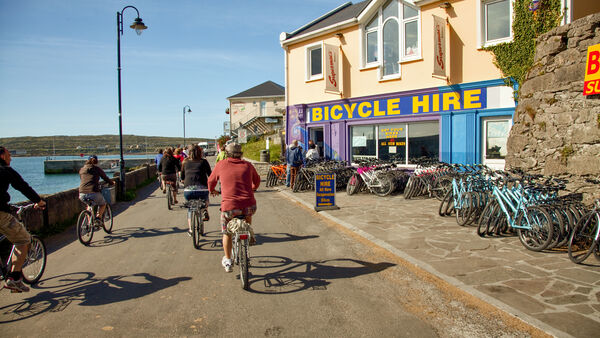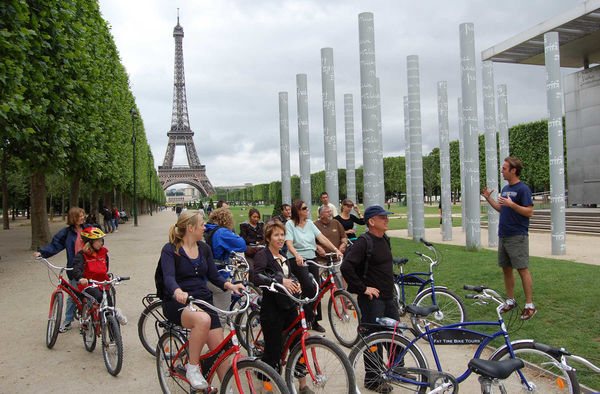Biking in Europe


By Rick Steves
In Europe, an afternoon on a bike — or a day, or weeks on end — gets you close to the ground and close to the people you came all this way to meet. Europeans love bicycles, and they are often genuinely impressed when they encounter Americans who reject the view from the tour-bus window in favor of huffing and puffing on two wheels. Your bike provides an instant conversation piece, the perfect bridge over a maze of cultural and language barriers.
City Biking
While my schedule usually won't allow a week-long pedal in the Loire Valley, I'll often do day trips in or around cities. I feel local, efficient, and even smug with my trusty and well-fitted bike. Especially during rush hour, I can get across town faster on a bike than by taxi or tram.
Europe's cities are striving to become more bike-friendly. Dozens of them have joined a European Union initiative to make bicycles on par with cars as a form of urban transport. The progress is gradual. Some cities (such as Rome and Athens) are not yet set up well for bikers, but quite a few (particularly Stockholm, Amsterdam, Copenhagen, Lucca, Salzburg, Munich, and Bruges) are a delight on two wheels, offering an extensive network of well-marked bike lanes. In these cities, rather than relying on walking or public transportation, consider making a bike your mode of transport. Bikes cut transit times in half compared to walking, giving you more time to spend at the sights.
Rental bikes are bargains at about $25 per day (the best deals are for multiple days); helmets aren't always available. Bike-rental shops generally provide strong locks. Always lock the frame (not the wheel) to the permanent rack. Bike thieves can be bold and brazen.
Many places including Barcelona, Copenhagen, Dublin, London, Oslo, Paris, and Vienna have citywide programs in which hundreds of free or cheap loaner bikes are locked to racks around town or freestanding. Similar to Lime in the US, Donkey Republic is a leading app-based bike-rental program in Europe. While tourists can easily take advantage of these bikes in cities like London and Vienna, in other places, the systems are designed mostly for residents (some require a membership or only take European credit cards). These bikes are usually very basic, sometimes in disrepair, and often plastered with ads — though new e-bikes are increasingly available for low-cost joyrides. But if you're serious about biking, rent a good one from a shop.
One of my favorite cities for a ride is Stockholm, which offers a shared e-bike program. Bike paths here are a city-planning priority, and they run along the entire harbor. On your bike you can join the urban paseo down Strandvägen — the harborfront of the trendiest neighborhood — to my favorite biking zone, Djurgården ("Animal Garden"), another former royal hunting preserve. Rolling down the garden-like lane past Rosendals Slott, the summer getaway minipalace of a 19th-century king, I marvel at how, on a bike, you see things that those on tour buses never would.
If you're hesitant to take a bike out on your own in an unfamiliar place, consider a bicycle tour. Guided bike tours are popular in cities throughout Europe, as well as many bike-friendly countryside areas. You'll get a young, entertaining, possibly foul-mouthed, sometimes informative guide who will give you a breezy introduction to the city and a close-up look at back streets few tourists ever see. The various companies are highly competitive and come and go all the time. Tours are typically fun, reasonable (about $35), good exercise, and an easy way to meet other travelers as well as get a new angle on an old city.
Countryside Biking
Biking in the boonies (using a small town as a springboard) is extremely popular in Europe. Thanks to the law of supply and demand, you can generally count on finding bike-rental shops wherever there are good bike-tripping options: along the Danube, the Rhine, and other idyllic river valleys; around Ireland's Dingle Peninsula; and in the Alps for mountain biking on service roads.
Biking is one of the most enjoyable ways to experience Austria's famous "Blue Danube." Bicyclists rule here, and you'll find all the amenities that make this river valley so popular with Austrians on two wheels. The best route starts west of Vienna in the village of Melk. From here, it's a three- to four-hour, gently downhill pedal to the riverside village of Krems. The best biking is on the south side of the river, which has a dedicated, paved bike path the whole way and plenty of vineyards and small inns (Gasthöfe) in the villages along the way.
From top to bottom, Switzerland's Lauterbrunnen Valley seems made to order for a bike ride, especially on a cloudy day when the Alps are hiding. From Lauterbrunnen town, you can either take a lazy pedal to the head of the valley, pausing to picnic and explore waterfalls — or enjoy an exciting downhill ride to Interlaken and take the train back. Or do both.
In France's Loire River valley, cycling options are nearly endless since the elevation gain is generally manageable. Amboise, Chenonceaux, Azay-le-Rideau, and Chinon all make good biking bases and have places to rent cycles. The city of Blois is well-positioned as a starting point for biking forays into the countryside. You can cycle from Blois to Chambord — the monumental chateau of François I — in a level, one-hour, one-way ride along a well-marked, 10-mile route, much of it a bike-only lane that follows the river.
For the best short bike trip out of Bruges, pedal 4 miles each way to the nearby town of Damme — once a thriving medieval port, and then a moated garrison town, and now a tourist center. Along the way you'll enjoy a whiff of the Belgian countryside and see a working windmill while riding along a canal to a charming (if well-discovered) small market town. The route is a straight and level ride through Belgium's polder — a salt marsh that would flood each spring until it was reclaimed by industrious local farmers.
In many countries (especially France, Germany, Austria, Switzerland, Belgium, and the Netherlands), train stations rent bikes and sometimes have easy "pick up here and drop off there" plans. If you ride the train into Amsterdam, rent a bike at the station for a few days to get around the city…and out into the tulip fields and windmills.
Longer Bike Trips
If you're interested in long-distance biking, figure out how much of Europe you want to see. With an entire summer free, you can cover a lot of ground on a bike. But with a month or less, it's better to focus on a single country or region.
Consider bringing your bike from home, but be sure to check your airline's baggage policies for fees and restrictions. It could cost you hundreds of dollars to bring your bike, and you may need to reserve a spot for it when you book your plane ticket. But if you're planning to ride a bike for more than a week, the cost of bringing your own may beat the cost of renting one in Europe, where bikes are more expensive than in the US. And having your own bike means you'll know that it works well for you. Carry along the tools you'll need to get your bike back into riding form so you can ride straight out of the airport.
Bikes add flexibility to your itinerary and can greatly extend the reach of your trip. There's nothing so sweet as taking a train away from the rain and into a sunny place. Unless you love bike camping, it makes sense to stay in hostels, hotels, or B&Bs, since it frees you from lugging around a tent and sleeping bag. If you'd rather let someone else carry your gear, try a bike tour (offered by REI, EuroVelo partners, and many other companies). With a guide to figure out logistics, haul supplies, and handle emergencies, all you need to do is pedal and enjoy the ride.
You can find many good books and resources on cycling in Europe, including the website EuropeBicycleTouring.

